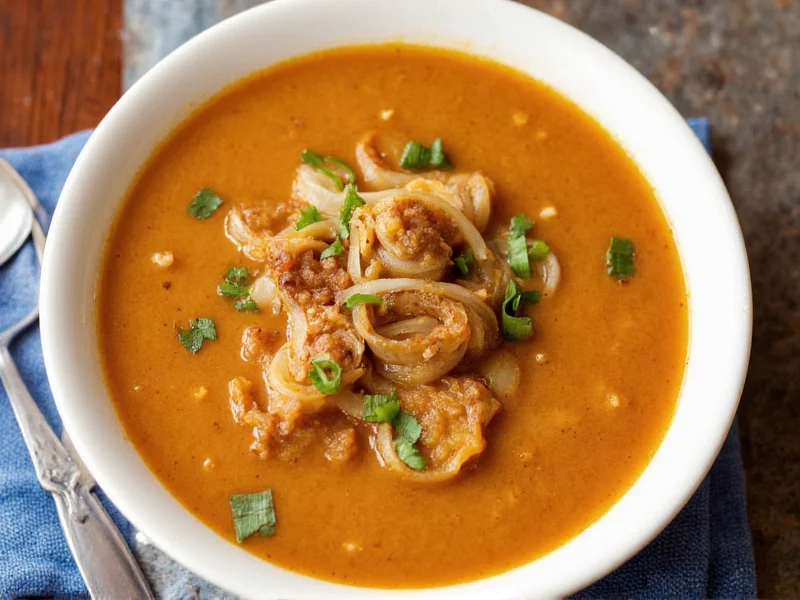For centuries, French onion soup has warmed tables across France and beyond with its rich, savory depth. This iconic bistro classic represents the beauty of French cuisine bourgeoise—simple ingredients transformed through careful technique into something extraordinary. While modern variations exist, understanding the authentic preparation reveals why this humble soup has earned its place among France's most beloved culinary exports.
The Historical Roots of a Classic
Contrary to popular belief, French onion soup didn't originate in medieval times as peasant food. Historical evidence points to its emergence in 18th century Paris, when street vendors began selling soupe à l'oignon to night workers returning from the opera or theater. The first documented recipe appeared in 1851 in Le Guide Culinaire by Alexis Soyer, though it differed significantly from today's version.
What transformed this simple onion broth into the dish we recognize today was the addition of toasted bread and melted cheese in the late 19th century. Parisian bistros adopted this enhanced version, and by the early 20th century, it had become a staple of French brasserie menus. American soldiers stationed in France during World War I brought their appreciation for this comforting dish back home, cementing its international popularity.
Authentic Ingredients and Their Purpose
True French onion soup relies on just a handful of quality ingredients, each serving a specific purpose in building flavor:
| Ingredient | Traditional Choice | Why It Matters |
|---|---|---|
| Onions | Yellow onions (Oignon jaune) | Higher sugar content creates deeper caramelization without bitterness |
| Fat | Butter (sometimes with olive oil) | Butter's milk solids contribute to fond development during caramelization |
| Liquid | Dry white wine followed by beef broth | Wine deglazes fond; quality broth provides umami foundation |
| Topper | Baguette slices with Gruyère cheese | Gruyère melts smoothly and complements onion sweetness |
Many American versions substitute chicken broth or add questionable ingredients like soy sauce or Worcestershire sauce—techniques that stray from authentic French onion soup preparation. Traditional recipes rely solely on the natural sweetness of properly caramelized onions and the depth of quality beef broth.
The Art of Proper Caramelization
The single most crucial step in creating authentic French onion soup is the caramelization process. Rushing this stage produces bitter, unevenly cooked onions that ruin the entire dish. Professional chefs typically dedicate 45-60 minutes to this stage alone.
Begin by thinly slicing onions uniformly—about 1/8 inch thick—to ensure even cooking. Cook them slowly over medium-low heat in butter, stirring occasionally but not constantly. The goal is to draw out moisture gradually, allowing natural sugars to caramelize without burning. Properly caramelized onions should be a deep, even golden brown—not blackened or spotty.
When executed correctly, this process develops complex flavor compounds through the Maillard reaction and caramelization, creating over 500 distinct flavor molecules that form the soup's foundation. This chemical transformation cannot be rushed or replicated with sugar additives.
Traditional Preparation Method
Following authentic French onion soup preparation requires patience and attention to detail:
- Caramelize onions slowly in butter over 45-60 minutes until deep golden brown
- Deglaze with dry white wine (traditionally Bourgogne Blanc), scraping up all fond
- Add quality beef broth (preferably homemade) and simmer 30 minutes
- Season carefully with salt, white pepper, and a pinch of thyme
- Toast baguette slices until crisp but not browned
- Float bread on soup and cover with grated Gruyère
- Melt cheese under broiler until golden and bubbling
The entire process typically takes 2-3 hours from start to finish, with the majority of time dedicated to proper onion caramelization. This time investment separates authentic French onion soup from quick versions that compromise flavor.
Common Mistakes to Avoid
Even experienced home cooks make critical errors when preparing French onion soup:
- Rushing caramelization - High heat creates bitter, unevenly cooked onions
- Using improper cheese - Mozzarella or cheddar won't replicate Gruyère's flavor and melt characteristics
- Over-seasoning - Authentic versions rely on onion sweetness, not heavy seasoning
- Using poor quality broth - Canned broth often contains competing flavors
- Adding thyme too early - Delicate herbs lose flavor during long simmering
One particularly common error is adding sugar to accelerate caramelization. While this creates color faster, it produces a different chemical reaction than slow cooking, resulting in one-dimensional sweetness rather than the complex flavor profile of properly caramelized onions.
Serving Traditions and Pairings
In France, French onion soup traditionally serves as a potage—the first course of a multi-course meal. It's rarely served as a standalone dish. The classic presentation features individual crocks with toasted baguette slices floating on top, generously covered with melted Gruyère that forms a golden lid when broiled.
Authentic French dining pairs this soup with:
- A crisp white wine like Chablis or Sancerre
- A simple green salad with vinaigrette
- French bread for dipping
The soup's rich umami profile makes it an excellent precursor to roasted meats or poultry dishes. In Parisian bistros, it often precedes steak frites or roasted chicken.
Variations vs. Authenticity
While culinary innovation has produced many French onion soup variations, certain modifications cross into inauthentic territory:
Acceptable variations:
- Using shallots for part of the onion mixture
- Adding a splash of cognac during deglazing
- Substituting beef broth with high-quality veal stock
Inauthentic modifications:
- Using chicken or vegetable broth as primary liquid
- Adding soy sauce, Worcestershire sauce, or other umami boosters
- Thickening with flour or cornstarch
- Using American cheese or other non-traditional cheeses
The essence of authentic French onion soup lies in its simplicity and reliance on the natural transformation of onions through proper technique—not supplemental flavor enhancers.











 浙公网安备
33010002000092号
浙公网安备
33010002000092号 浙B2-20120091-4
浙B2-20120091-4